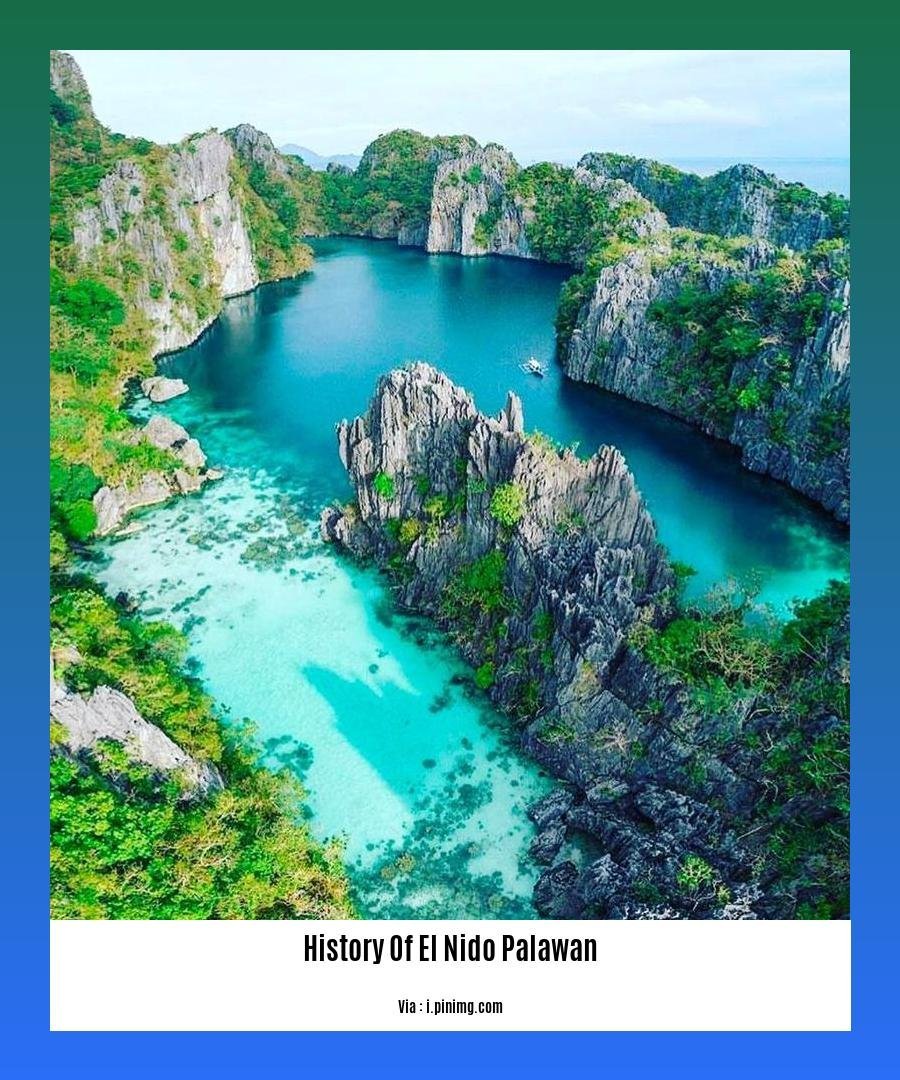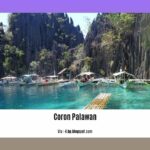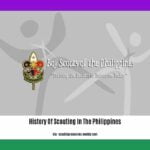Embark on a journey through time as we explore El Nido, Palawan’s captivating past in our article, “Embracing History’s Embrace: A Journey Through El Nido, Palawan’s Past.” Let’s uncover hidden stories and intriguing historical narratives that bring this captivating destination to life.
Key Takeaways:
El Nido, Palawan has a rich history dating back to the Tabon culture, one of the earliest known human settlements in the Philippines.
The town was originally named Talindak by the Tagbanwa people, who were the area’s original inhabitants.
In the 1800s, the Spaniards renamed the town to Bacuit.
El Nido got its current name in 1954, derived from the Spanish word for “The Nest” due to the edible nests of swiftlets found in the limestone cliffs.
El Nido’s transformation into a popular tourist destination began in 1982 when a resort was established on Pangalusian Island.
The town’s stunning natural beauty, including its limestone karsts, pristine beaches, and crystal-clear waters, has made it a popular destination for travelers worldwide.
Despite its growth in tourism, El Nido has managed to preserve its unique cultural heritage and traditions, making it a fascinating place to visit and learn about Philippine history.
History of El Nido, Palawan
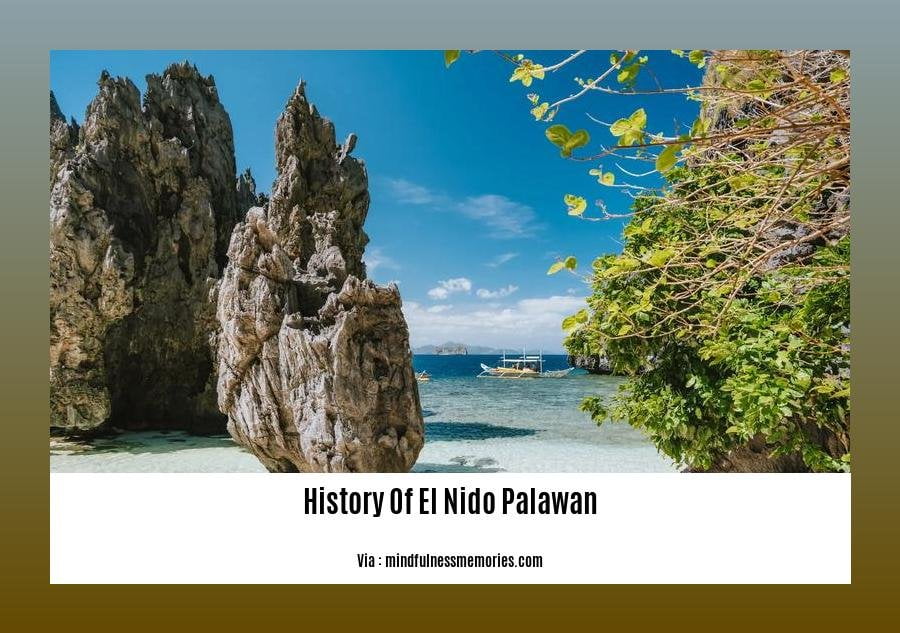
El Nido, a captivating town nestled in the arms of Palawan, Philippines, boasts a rich and storied past that dates back to the Tabon culture. These early inhabitants left their mark on the land, shaping its destiny for centuries to come.
In the 1800s, Spanish colonizers arrived, renaming the Tagbanwa village of Talindak to Bacuit. This marked a significant turning point in El Nido’s history, as it ushered in a new era of influence and cultural exchange.
The year 1954 witnessed another pivotal moment: Bacuit was bestowed with its current name, El Nido, a Spanish term meaning “The Nest.” This name was inspired by the edible nests of swiftlets found in the town’s majestic limestone cliffs, a testament to the town’s unique natural features.
El Nido’s transformation into a renowned tourist destination began in 1982 with the establishment of a resort on Pangalusian Island. This development opened the door to a new chapter in El Nido’s history, as travelers from around the world flocked to experience its breathtaking landscapes and immerse themselves in its rich cultural heritage.
The Tabon Caves: A Glimpse into El Nido’s Ancient Past
El Nido’s fascinating history is intimately intertwined with the Tabon Caves, located just a short distance from the town. These caves have yielded a treasure trove of archaeological discoveries, including the remains of the Tabon Man, one of the earliest known human inhabitants of the Philippines.
The Tabon Man, along with other artifacts unearthed in the caves, provides valuable insights into the lives of our ancient ancestors. These findings have helped to piece together the puzzle of human migration and settlement in the Philippines, shedding light on the origins of the Filipino people.
El Nido Today: A Thriving Tourist Destination
Today, El Nido stands as a testament to its enduring legacy, having transformed into a thriving tourist destination that continues to captivate travelers with its pristine beaches, towering limestone karsts, and vibrant marine life.
The town’s rich history and cultural heritage serve as a magnet for visitors seeking to delve into the depths of the Philippine past while immersing themselves in the beauty of the present. El Nido’s story is one of resilience, transformation, and the enduring power of human connection, a story that continues to unfold with each passing day.
So, come, explore the wonders of El Nido, Palawan, and immerse yourself in the embrace of its storied past, where history and natural beauty converge to create a truly unforgettable experience.
Dive into the rich history of East Africa as you explore comprehensive notes on the region’s past, from ancient civilizations to modern-day complexities. history of east africa o level notes
Unravel the intriguing history of Eastern Samar, an island province in the Philippines, as you delve into its captivating tales of resilience and cultural heritage. history of eastern samar
Embark on a journey through the annals of the Evangelical Church of West Africa (ECWA), tracing its humble beginnings, its pivotal role in shaping Nigeria’s religious landscape, and its ongoing mission to spread the gospel. history of ecwa
Role of El Nido in the World War II era
El Nido, nestled in the heart of Palawan, bore witness to the tumultuous events of World War II, leaving an indelible mark on its history. The Japanese Imperial forces occupied the Philippines, including El Nido, from 1942 to 1945. During this dark period, the town served as a strategic location for the Japanese due to its proximity to Bacuit Bay, a natural harbor.
The scars of war still linger in El Nido, serving as a poignant reminder of the resilience and bravery of its people. One of the most significant relics from this era is the Japanese Shrine, hidden deep within the lush forests of the town. The shrine, constructed by Japanese soldiers, stands as a haunting testament to the conflict’s presence.
El Nido’s coastline, dotted with hidden coves and inlets, provided a sanctuary for Filipino guerrillas who resisted the Japanese occupation. These brave men and women, known as the “Palawan Resistance Movement,” operated from the shadows, conducting covert operations and sabotaging Japanese supply lines.
Key Takeaways:
- Japanese occupation of El Nido during World War II (1942-1945)
- Strategic location of Bacuit Bay as a natural harbor.
- Japanese Shrine as a poignant reminder of the war.
- Filipino guerrillas’ role in the Palawan Resistance Movement.
- Coastal coves and inlets as hideouts for resistance activities.
Sources:
- El Nido, Philippines: A Historical Perspective
- Palawan in World War II
Indigenous communities and their cultural influence in El Nido
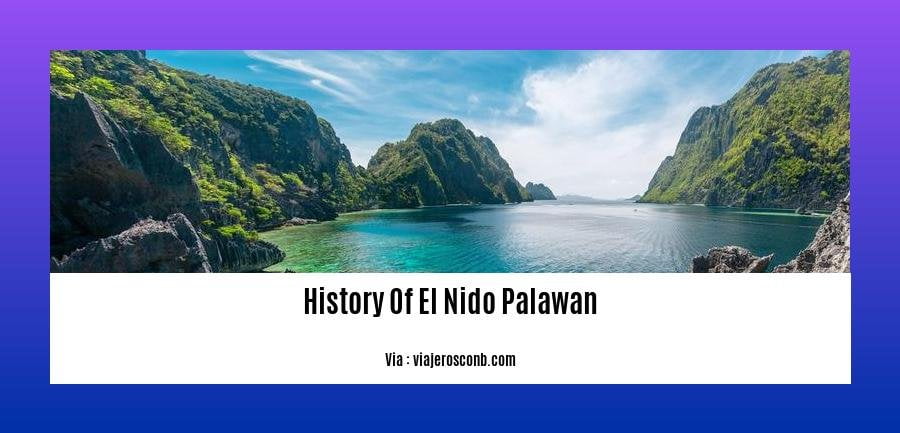
A Tapestry of Traditions: El Nido’s Indigenous Roots
El Nido’s story is inseparable from its indigenous communities, guardians of the land’s rich cultural legacy. The Palawan people, the original inhabitants of El Nido, have woven a vibrant tapestry of traditions and customs that remain deeply embedded in the region’s soul.
The Palawan’s Enduring Legacy:
Artisans of Life:
The Palawan people are talented artisans, crafting intricate mats, baskets, and carvings from natural materials like rattan, abaca, and bamboo. Their skilled hands breathe life into these creations, transforming them into functional works of art.Living in Harmony:
The Palawan people hold a deep respect for nature, living in harmony with their surroundings. Their traditions emphasize sustainable practices, ensuring the land’s resources are preserved for generations to come.Guardians of the Land:
As stewards of the land, the Palawan people possess an encyclopedic knowledge of the local flora and fauna. They share this wisdom with visitors, fostering a greater appreciation for El Nido’s delicate ecosystem.
Language and Traditions: A Living Legacy
The Palawan language, Tagbanwa, is a testament to their rich heritage, a living language passed down through generations. Storytelling holds a central place in their culture, with tales of ancient spirits and mythical creatures captivating listeners, young and old.
Embracing the Palawan Heritage
El Nido offers visitors a chance to immerse themselves in the Palawan culture. Homestay programs and cultural tours provide an intimate glimpse into their way of life, fostering meaningful connections and a deeper understanding of their traditions.
Preserving the Past, Shaping the Future
The Palawan people’s cultural influence is ever-present, shaping the fabric of El Nido’s identity. Their traditions, passed down through generations, continue to guide the community, ensuring their heritage remains a vibrant part of El Nido’s future.
Key Takeaways:
El Nido’s indigenous communities, particularly the Palawan people, have played a pivotal role in shaping the region’s cultural identity.
The Palawan people’s traditions, customs, and language, Tagbanwa, reflect their deep connection to nature and their way of life.
Artisanship, storytelling, and a profound respect for the environment are integral to the Palawan culture.
El Nido offers visitors opportunities to engage with the Palawan people, learn about their heritage, and immerse themselves in their vibrant traditions.
Preserving and celebrating the Palawan culture is essential for safeguarding El Nido’s unique identity and ensuring its continued vibrancy.
References:
- El Nido’s Indigenous Communities: A Cultural Tapestry
- Exploring the Palawan Heritage in El Nido
El Nido as a haven for biodiversity and natural wonders
El Nido is an extraordinary kaleidoscope of turquoise waters, towering limestone karsts, and an unparalleled array of biodiversity. Its status as a haven for natural wonders is a testament to the intricate tapestry of ecosystems that thrive within its borders. Let’s dive into the marvelous diversity that makes El Nido a sanctuary for nature enthusiasts.
The Realm of Coral Gardens and Marine Delights
The vibrant coral gardens of El Nido paint a picture of an underwater paradise. These gardens are a haven for a kaleidoscope of marine life, from the graceful manta rays gliding through the depths to the playful dolphins cavorting in the waves. The translucent waters offer a window into a teeming world, where schools of colorful fish dart in and out of coral formations, creating a mesmerizing dance of colors.
The Secret Sanctuaries of Turtles and Birds
El Nido serves as a sanctuary for turtles and birds, providing them with a safe haven to thrive and flourish. The pristine beaches are nesting grounds for turtles, where they lay their eggs under the watchful eye of conservationists. Sea turtles, with their ancient wisdom, glide through the waters, embodying the spirit of resilience.
The skies of El Nido are alive with the songs and calls of a diverse chorus of birdlife. From the majestic Philippine eagle soaring overhead to the tiny sunbirds flitting among the trees, each species plays a vital role in the delicate balance of this ecosystem.
A Legacy of Conservation and Sustainable Tourism
The people of El Nido understand the importance of preserving their natural heritage for generations to come. They have embraced sustainable tourism practices, ensuring that the delicate balance of their environment remains intact. This commitment to conservation guarantees that future visitors can continue to marvel at the unspoiled beauty of El Nido.
Key Takeaways:
- El Nido’s coral gardens are a haven for marine life, offering a breathtaking glimpse into the wonders of the underwater world.
- The pristine beaches of El Nido provide a safe sanctuary for turtles to nest, ensuring the survival of these gentle creatures.
- El Nido’s skies are alive with a symphony of bird songs, showcasing the diversity and beauty of the region’s avian life.
- The people of El Nido are committed to sustainable tourism, ensuring that the natural wonders of their home remain intact for future generations.
Sources:
- El Nido-Taytay Managed Resource Protected Area
- El Nido’s Marine Biodiversity: A Haven for Marine Life
FAQ
Q1: What evidence supports the claim that humans have inhabited El Nido for over 22,000 years?
A1: Artifacts discovered in the Ille Cave in New Ibajay serve as evidence of human habitation in El Nido dating back to at least 22,000 years ago.
Q2: When did El Nido receive its current name, and what does it mean?
A2: In 1954, El Nido was given its current name, which means “The Nest” in Spanish. This name was inspired by the edible nests of swiftlets found in the limestone cliffs of the area.
Q3: How did El Nido gain global recognition as a tourist destination?
A3: El Nido gained widespread global attention due to its stunning natural features, including white beaches, towering limestone cliffs, mesmerizing lagoons, incredible wildlife, and vibrant coral gardens.
Q4: What significant events occurred during the Spanish and American periods in El Nido’s history?
A4: During the Spanish era, El Nido was under Spanish rule for over 300 years. The Spanish introduced Christianity and other aspects of their culture to the region. In the late 19th century, the Americans arrived in El Nido and established a naval base. They governed the area for over 50 years, introducing modern amenities such as schools, hospitals, and roads.
Q5: What conservation measures have been implemented to protect El Nido’s unique ecosystem?
A5: In recognition of its distinctive ecosystem, the Philippine government has designated El Nido as a turtle sanctuary (1984), a marine reserve park (1991), and finally a managed resource protected area (1998). These measures aim to ensure the sustainable preservation of El Nido’s rich biodiversity.
